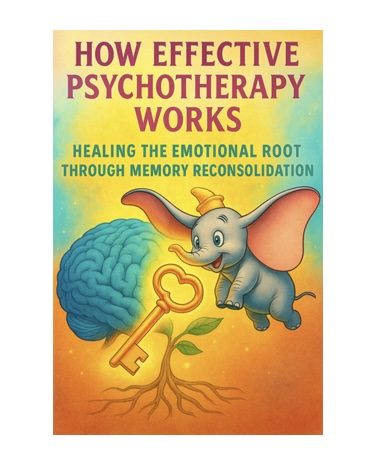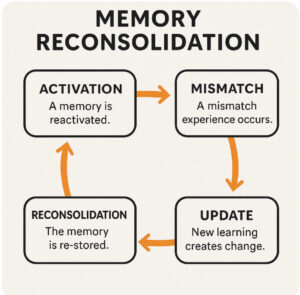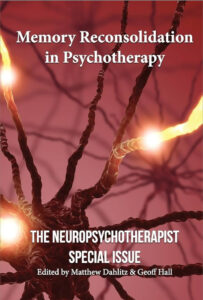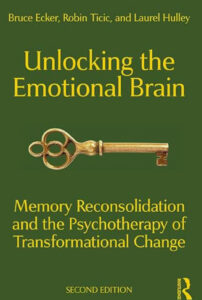Coping Isn’t the Goal. Healing Is.
If your therapy sessions focus only on “talk therapy” (CBT), you’re limiting the potential for deep, lasting transformation.
All effective therapy modalities incorporate memory reconsolidation into their processes. The best therapeutic approaches don’t just manage behaviors or regulate emotions—they dissolve the emotional charge linked to memory itself.
This is a 7-minute summary video on this important subject:
:
What Is Memory Reconsolidation?
Memory reconsolidation is a neurobiological process in which emotional memories become temporarily “unstable” when recalled. During this 4–6 hour window, the brain is open to change—allowing new emotional learning to be integrated directly into the old memory.
When the new experience or perspective contradicts the original emotional truth, the brain rewrites the memory, often dissolving the emotional pain that once accompanied it.
Put simply: when fresh information is woven into a traumatic memory, the meaning of that memory shifts—and with it, the emotions tied to it.
This isn’t about managing symptoms or learning to cope.
It’s about healing at the source.
Who Discovered It?
In the early 2000s, Karim Nader and Joseph LeDoux demonstrated in animal studies that reactivated fear memories could be erased by disrupting the reconsolidation process.
But in clinical practice, this process had been quietly unfolding for decades. Here are examples of one modality that was using Memory Reconsolidation almost 50 years ago:
- 1970s: NLP’s Trauma/Phobia Cure → See how I cured my own PTSD
- Later: The Rewind Technique
- Then: The Movie Theater Technique
- Today: Rebranded as RTM (Reconsolidation of Traumatic Memories) Trademarked
When Naming Gets in the Way of Healing
Over time, some techniques have been rebranded by those seeking recognition or control. What began as a shared clinical discovery is now entangled in trademarks and proprietary licenses.
Someone trademarked the name RTM—despite the core process dating back over 50 years.
RTM, once a broad method, is now boxed into a narrowly defined protocol. As a result, therapies that successfully facilitate reconsolidation are often excluded—simply because they aren’t branded “RTM.”
Let’s Separate the Signal from the Noise
To clarify:
- RTM : A trademarked scripted adaptation of NLP’s Trauma/Phobia Cure
- Reconsolidation-Based Therapies: Any modality that uses reactivation + contradiction to transform trauma memory
This distinction restores freedom to healing—without gatekeeping.
Examples of Reconsolidation-Based Therapies
- Trauma/Phobia Cure (RTM)
- The Haven Technique
- Dynamic Spin Procedure
- The In Technique
- Eye Movement Integration (EMI)
- FreeSpotting
- BrainSpotting
- Clean Language Therapy (my favorite)
- EMDR
- The Flash Technique
- Coherence Therapy
- (If your favorite isn’t listed—no worries. If it works via reconsolidation, it belongs.)
Milton H. Erickson, MD (1901–1980)
Renowned hypnotherapist Milton Erickson never used the term memory reconsolidation—it hadn’t been discovered yet. But his therapeutic methods mirror the core steps:
- Memory Reactivation – through story, metaphor, or trance
- Mismatch – introducing emotional novelty during recall
- Emotional Update – allowing new meaning to reframe the past
Examples include:
- Hypnotic age regression with emotional resolution
- Transformational metaphors
- Using the client’s own internal resources
- Strategic confusion to allow reinterpretation
Erickson’s work proves the healing arc was in motion—long before science gave it a name.
The Three Phases of Reconsolidation
Clean Language Therapy– Working With Metaphors:
Phase 1: Reactivate
“And when you are depressed, whereabouts are you depressed? Inside or outside your body?” (A dark cloud in head)
Phase 2: Mismatch
“And what would that Dark Cloud like to have happen?” (It wants to float up)
Phase 3: Re-encode
(It floats up.) “And is there anything cloud needs? “No”
The result? The client reported full resolution of major depression—sustained even in a follow-up 29 years later. There is a 6-minute recording of this session:
https://clintmatheny.com/healing-major-depression/
Timing Is Everything
- Memory destabilizes within minutes of recall
- The reconsolidation window lasts 4–6 hours
- When done effectively, emotional erasure can happen in under 60 minutes—sometimes even in just a few minutes
Why This Matters
They offer freedom.
They do this by:
- Reactivating emotional learning
- Disconfirming outdated emotional truths
- Re-encoding liberating emotional experiences
Triggers quiet down.
Shame detaches.
Panic dissolves.
And unless new emotional learning contradicts it again—it doesn’t return.
Healing Should Be Open Source
Memory reconsolidation belongs to the nervous system—not to a brand.
We don’t need more names. We need shared understanding. We need therapies that prioritize healing over packaging for dollars.
When we follow biology—not branding, we unlock transformation that lasts.
In Summary
It may sound simplistic, but if your client does something different—“behaviorally”—while inside the trauma (not just talking about it, but truly “in” it), they’ll change their emotional response. That’s the doorway to reconsolidation.
Emotional healing can’t occur while clients are numbed by psychotropic medications (Antipsychotics, benzodiazepines, SSRIs). You can’t heal what you can’t feel!
Since 1980, the U.S. medical model often prioritizes short-term symptom relief over true transformation. While medications may help stabilize clients in crisis, long-term healing, especially through memory reconsolidation, requires clients to fully access and process their emotions – not suppress them.
If the emotional and bodily sensations are numbed—whether by medication, alcohol, or dissociation—the first step is weakened. Without fully feeling the memory, the brain doesn’t unlock it, so the reconsolidation process never starts.
Clarifying note
While I have worked with many clients who were taking medications, I gently remind them that medications can sometimes limit access to sustained emotional states. Because of this, much of our therapeutic work focuses on the cognitive mind—exploring thoughts, beliefs, and meaning—rather than fully entering the deeper, felt experience of the unconscious mind-body. We adapt by listening in new ways and honoring the emotional self, even when it may be harder to reach.
Recommended Readings:
Clint77090@gmail.com




